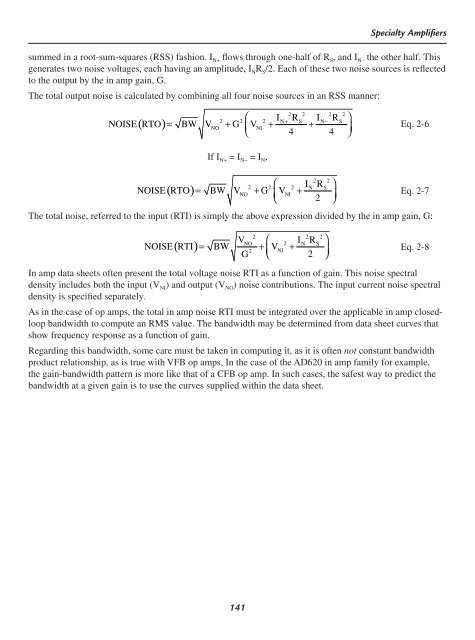Op Amp Applications Handbook Walt Jung, Editor
Op Amp Applications Handbook Walt Jung, Editor
Op Amp Applications Handbook Walt Jung, Editor
Create successful ePaper yourself
Turn your PDF publications into a flip-book with our unique Google optimized e-Paper software.
141<br />
Specialty <strong>Amp</strong>lifi ers<br />
summed in a root-sum-squares (RSS) fashion. IN+ fl ows through one-half of RS, and IN– the other half. This<br />
generates two noise voltages, each having an amplitude, INRS/2. Each of these two noise sources is refl ected<br />
to the output by the in amp gain, G.<br />
The total output noise is calculated by combining all four noise sources in an RSS manner:<br />
2 2 2 2<br />
⎛ 2 2 2 IN RS IN R ⎞<br />
+ − S<br />
NOISE( RTO) = BW VNO + G ⎜VNI + +<br />
⎝ 4 4<br />
⎟<br />
⎠<br />
If I N+ = I N− = I N,<br />
2 2<br />
⎛ 2 2 2 IN R ⎞ S<br />
NOISE( RTO) = BW VNO + G ⎜VNI +<br />
⎝ 2 ⎟<br />
⎠<br />
Eq. 2-6<br />
Eq. 2-7<br />
The total noise, referred to the input (RTI) is simply the above expression divided by the in amp gain, G:<br />
2 2 2<br />
V ⎛ NO 2 INR ⎞ S<br />
NOISE( RTI) = BW + V<br />
2 NI<br />
G<br />
⎜ +<br />
⎝ 2 ⎟<br />
⎠<br />
Eq. 2-8<br />
In amp data sheets often present the total voltage noise RTI as a function of gain. This noise spectral<br />
density includes both the input (VNI) and output (VNO) noise contributions. The input current noise spectral<br />
density is specifi ed separately.<br />
As in the case of op amps, the total in amp noise RTI must be integrated over the applicable in amp closedloop<br />
bandwidth to compute an RMS value. The bandwidth may be determined from data sheet curves that<br />
show frequency response as a function of gain.<br />
Regarding this bandwidth, some care must be taken in computing it, as it is often not constant bandwidth<br />
product relationship, as is true with VFB op amps. In the case of the AD620 in amp family for example,<br />
the gain-bandwidth pattern is more like that of a CFB op amp. In such cases, the safest way to predict the<br />
bandwidth at a given gain is to use the curves supplied within the data sheet.






